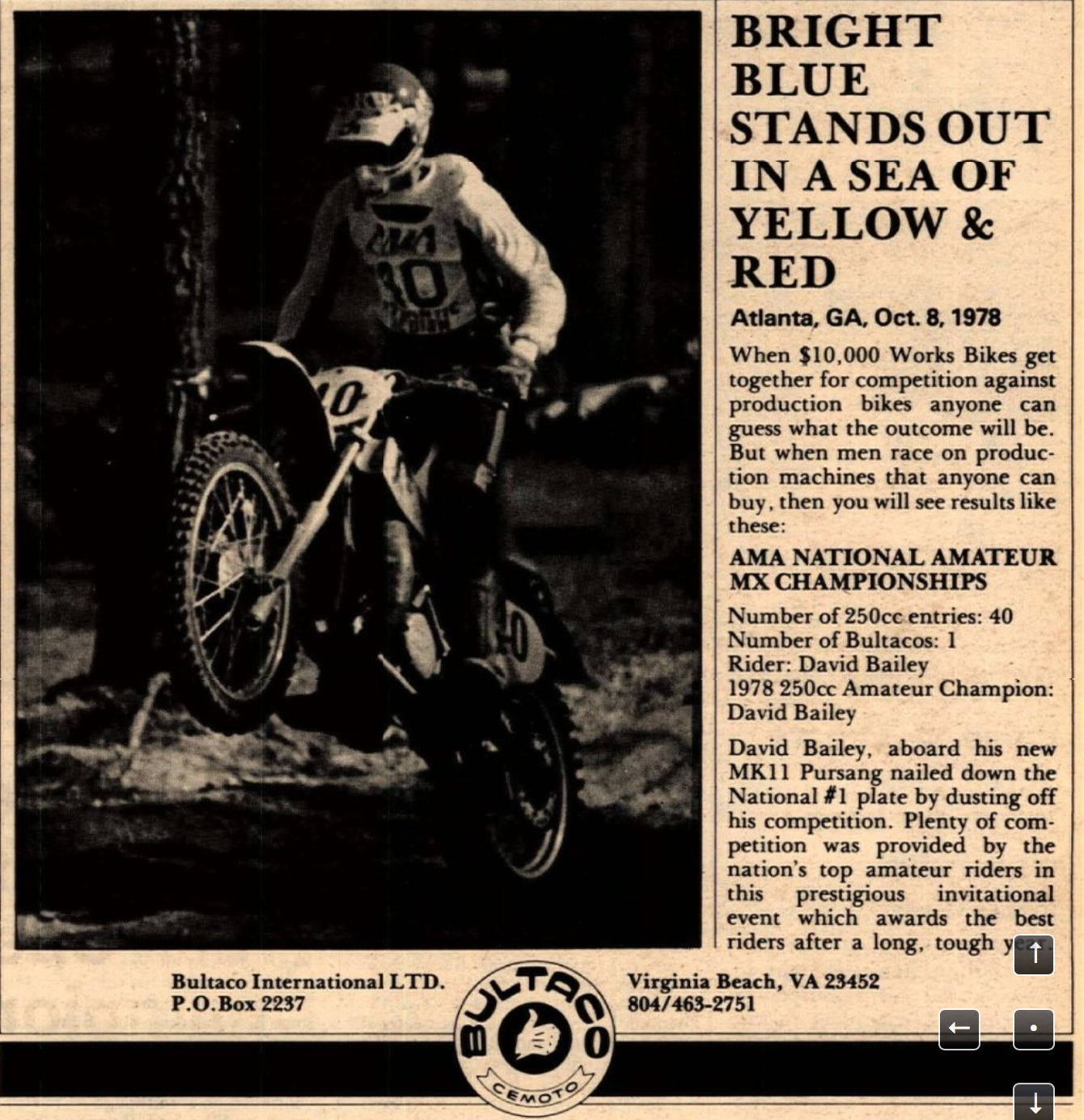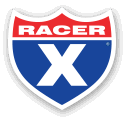This is Part 4 of our ongoing series Before Loretta’s, a look back at the old AMA Amateur and Youth/Minicycle Nationals that took place between 1975 and ’81. If you have any information or or photos or results to add, please email: DC@racerxonline.com.
As we rolled into the 1978 AMA Amateur National, the fourth year of these stand-alone events, none of the three past winners of the 125 class were there. The first champion in ‘75, Illinois’ Mark Barnett, was by this point a Suzuki factory rider winning 125 Pro Motocross Nationals as he battled Yamaha’s Broc Glover for the championship. The 1976 winner, Ferrell McCollough, came back in ’77 to win the 250 AMA Amateur National title, but after that decided to focus on his studies at the University of Maryland. And the ’77 winner, Jeff Callihan of Virginia, decided to turn pro in 1978. He would earn a handful of points over the next couple of years in the 125 Nationals, but never quite make it into the top ten.
“I did some of the 125 Nationals but not all of them over the next year or two,” says Jeff Callihan. “My pro career was average—I made some nationals and finished in the points—and while it was nothing spectacular, it’s still a memory and I’m proud of it.” Scoring points back then, when every factory rider had a full-works motorcycle, was no easy feat. Here are Jeff Callihan’s pro results in The Vault.
As for that fine day in October of 1977, Callihan remembers, “Lake Sugar Tree was a mudder, and that definitely benefitted me because I grew up that way—I was from an area (Virginia) where we had a lot of rain and mud races in the winter, so I had a little bit of an advantage over the California guys when it came to mud,” says Callihan.
At the race in 1977 there was an epic first-turn crash that took out half of the 125 pack, and that photo ran in the CN East edition. If you look closely in the middle, one of the last riders getting through, already covered in mud, is Jeff Callihan.

“Yes, that’s me, right in the middle going around everybody!” he laughs. “The first moto I was still mid-pack after missing that wreck in the first turn, and I came back up to fourth, which was pretty good considering where I started and all of the fast guys that were there.
“In the second moto I led the whole thing until the white flag, the last lap, and me and Jimmy Lauer got together behind the dam and I tipped over and ended up finishing second,” he explains. “At the time I didn’t know that I was still going to be the winner with a 4-2, and of course by the time I got back my mom had it all figured out!”
This was the first year that Suzuki sponsored the event, and Callihan was only the winner aboard one. After the race he was given a brand new RM125. Afterwards he decided that winter to turn professional, and he and his friend Mike Twigg ended up going down south to race the Florida Winter-AMA Series. After that he raced a handful of 125 Nationals, as mentioned above.
When Loretta Lynn’s started up in 1982, Callihan returned as a Pro-Am and finished eighth in the 125 A Stock class. More than 30 years later he returned again, this time with one of his sons.
“My oldest son, who is 30 now, is into moto as well as NASCAR. We went to Loretta’s together in 2015, which was really fun and special. I mean, how often do you get to go to Loretta Lynn’s with your son? Especially since I went to the first Loretta Lynn’s in 1982, and then 30 years later came back, actually from 2013 to ’15. Those were all cherished memories.”
In 2014 Callihan finished 18th in the Masters +50 class. And of course way back in 1977 he was the AMA 125cc Amateur National Champion, no easy feat. But those old races—the ones before Loretta’s—have largely been overlooked or just plain forgotten by history.
“They have been overlooked because they were just different back then,” says Callihan. “They were a one-day show, you had to be in the A class to be there, and it just didn’t get the notoriety back then that it does now.”
Callihan is right. Coverage in the magazines for amateur motocross back then was almost non-existent, and even Cycle News, which had East, West and Central editions at the time, was inconsistent—the ’77 AMA Amateur National at Lake Sugar Tree, which Callihan won, received a spread in Cycle News East but just one page and one photo in the West editions, and so far those are the only editions that were scanned for the online Cycle News Archive (which, by the way, is a wonderful investment and the best $5 you will ever spend!)
Here’s an added note: Jeff Callihan also won a Youth AMA National back in 1974, when the AMA was running an AMA/Youth National Series, not one-off races. He won the 100cc class at the round at Sparks, Maryland.
Now, let’s move on to 1978 and what’s now called the AMA Mr. Pibb/Toyota/Suzuki Amateur National Motocross Championships. The race was set for October 8 moved again at Atlanta International Raceway, located in Hampton, Georgia, about 50 miles northeast of the Road Atlanta facility that used to host a few Trans-AMA races and outdoor nationals. For its part Atlanta International Raceway, promoted by Bill West, on a track built by Gary Bailey, would host three AMA Pro Motocross races (1978-’80), with six different winners between the two classes: Broc Glover (125) and Rick Burgett (500) in ’78; Bob Hannah (250) and Danny Laporte (500); Kent Howerton (250) and Chuck Sun (500) in 1980.
The track itself did not prove very popular with the riders. It was mostly flat and fast. It was also very dry, so fabric shards from a nearby carpet factory were dumped like sawdust to dry to keep the dust down. It had the unintended effect of making different parts of the track different colors, depending on the color of the carpet threads dumped there.
“The Georgia race was kind of a homemade track there,” recalls Jeff Surwall, an LOP Suzuki rider from Illinois. “They had carpet fibers and pillows and stuff all over the ground, it was pretty weird. It was so terribly dusty that I ran off the track without realizing it and hit a drain culvert and went flying!” Surwall would only finish 17th in the 125 class one year after finishing third at Lake Sugar Tree. He would turn pro the following year.
“The track was really strange because they used those carpet fiber on the track to keep the dust down, so when they watered the track it would stay moist, so it was a really weird texture for a track,” remembers Mark Hinkle, from South Haven, Michigan, who had finished eleventh the previous year in the 250 class. “I had a front flat tire for about 80% in one of the motos, plus some other issues, but that was the big thing that put a kibosh on me.”
One year later he went to the race near Atlanta aboard a Spanish-made Montesa, and it started even worse when he was landed on in practice by another rider. “They had a great big spike jump, and I went up off that and someone else landed on me and folded the bike all up,” he explains. “We spent the rest of the time before the start of the motos switching parts off other bikes to build it back, so we weren’t even sure we were even going to be able to run it.”
“The track was super dry, even with the cotton fiber mixed in,” recalls David Bailey, who was there to race the 250 class after finishing sixth in the 500 class the year before. “One corner would be like powder blue, and the next would be a little bit pink, but it was all dusty. You would go to hit a big berm and it would just be powder—you would blow right through it.”
When asked what else he remembers about the lead-up to the ’78 AMA Amateur National, Bailey says, “During that season I was wearing Lancer pants, which was actual leather—that’s why motocross pants used to be called ‘leathers’! But my mom (Darlene) knew Rita Gregory (from JT Racing) and she told me to call her. I was so nervous I didn’t want to do it, but Rita was super nice to me. She gave me a little bit of a lesson in how to ask for things and how to appreciate it, and so JT Racing ended up sponsoring me with blue-and-white nylon JT pants and a jersey. When I ended up on the cover of Cycle News she was so excited!”
Bailey was looking for redemption from the previous year’s letdown at his home track, but he got off to an auspicious start when his Bultaco Pursang blew up in practice. With his step-dad Gary’s help they were able to get a new piston and rings in the bike before the start.

“I went to the starting line with my hands smelling like gas because we had just finished working on the bike,” says Bailey. “And then I went down in like the second or third turn. This was right after I had seen the ’78 Pittsburgh Supercross with Bob Hannah coming from way back to win at the end, and I thought to myself, ‘Hannah could win this still.’ So as I’m getting up after a lousy morning, on top of a down-on-power bike, and then crashing, all I could think of was that Hannah could still win, and I want to be like that.’ So I just kept going and going, picking guys off until I made it to the front and won the moto.
“I went into that race with a chip on my shoulder that had been there for a whole year,” he admits. “I knew it was my last year as an amateur and I didn’t want it to slip away from me again. I was like the only guy to be disqualified at Lake Sugar Tree, where everyone thought I should have won because it was my home track and all, but now I just wanted to beat them in Georgia. After the bad start and the crash, that was exactly the right fuel I needed to actually come back and win that thing.”
Bailey had to overtake yet another fast Michigan rider in Shane Hruska, who rode a Maico, and Wisconsin’s Jeff Jacobson.
In the second moto Bailey found himself behind a familiar fast guy in Jimmy Lauer, who hailed from Maryland, so they raced together often.
“We didn’t get along real well,” he says of a Lauer, who rode a Yamaha, and then qualifies it by adding, “Well, our parents didn’t get along real well—it was such craziness back then! But Jimmy was faster, but he didn’t do so well in the first moto (fifth) so I knew I could let him go and finish second and still win, so that was how it ended up.”
One year later Bailey went back to Atlanta International Raceway for what would be just his second AMA Pro Motocross race. He would enter the 250 class and line up against the very same Bob Hannah whom had motivated him to win the year before.
“Bob had broken his hand the weekend before at Southwick when he whacked it on a post or a tree, and I remember thinking, ‘Hey, I won the AMA Amateur National Championship here, I’m going to do good here.’ Well, broken hand and all, Hannah and Howerton lapped me! Driving home from that national I remember thinking, Um, I’m never going to be that good. Man, what a wake-up call.”
How did Bailey even manage to make his antiquated Bultaco work?
“Trial and error,” he says. “I spent as much time working on that bike and thinking about it, and thinking about upcoming races, as I did riding. And I rode a lot. If I wasn’t in school I was riding, and then the only reason I was not riding was because it was getting dark. I would come home and get the drill out and the file and just start going to town on it. I thought the Hondas looked really cool when they switched to all red, so I painted my Bultaco all blue because I wanted it to look as cool as a Honda!

“I would pull the bike apart, split the cases and inspect every part trying to figure out how I could make it better, and just became kind of my own developer,” says Bailey, who would go on to become a superstar for Team Honda in the 1980s and win AMA Supercross, 250 Pro Motocross, and 500 Pro Motocross Championships. “I would go to the machine shop in town and get the giant flywheel machined down so it revved like a Japanese bike. I really, really studied how to make the bike better. I learned a little bit from Bevo Forti, since he had been John Savitski’s mechanic when he was racing Bultacos, like how to cut the back of the piston and all of this little things that I picked up from just being at the races. In 1978 it all come together one last time and that Bultaco worked. I made it last a little bit longer, but it took three bikes to make one—they weren’t anymore Bultaco parts to be found. I had to re-fiberglass the tank and everything.”
Bailey would race basically the same bike in 1979 as a rookie pro before being thrown a lifeline from a new program on the rise—Kawasaki Team Green. “If it hadn’t been for Team Green, I might have ended up in construction.”
Bailey’s was the only Bultaco in the 1978 AMA Amateur National. His last result on a Bultaco—14th at the ’79 High Point 250 National—was the last result ever for Bultaco in AMA Pro Motocross.

“We used to ride the trails up in Northern Michigan and I was always seeing guys out there on bike with number plates and stuff and we used to stay with up them, but didn’t really give it much thought,” says Mark Hinkle of his first foray into motorcycling. He would win the 500cc class in Georgia. “Pretty soon we got into drag racing, then we went to flat track. It was something I had never done before, so I was doing better in every race. At one race it started raining so they all packed up and went home. And I said, ‘Well that wasn’t any fun.’ The next day they had a motocross over at RedBud so we put the knob tires on the back and went over to RedBud, and that’s how we ended up getting into motocross.” His younger brother Scott started racing too, albeit on smaller bikes.
Did Hinkle ever think that he would go from that modest start to becoming one of the winningest amateur motocross riders in the country at that time? “Oh of course not. I started out running well, but not anything where you would expect it to end up like it did. At that point I had never even heard about the nationals. Everything was just a regular race.”
Hinkle ended up winning both motos over a Yamaha rider from Oklahoma named John Day and fellow Michiganer Rusty Hibbs of Team Dynamic. Day was leading the second moto and had a clear shot at the title, only to fall in the late going and opening the door for Hinkle to run him down.
Finishing fourth was Maryland Maico rider Glenn Taylor. Another Maico rider, Eric McKenna from California, was expected to be up there too, but he crashed in practice and ended up breaking his leg. He would have to wait another year to make his mark in the AMA Amateur Nationals.
For his efforts Hinkle remembers being rewarded a brand new Suzuki RM from Mark Barnett, on hand as Suzuki’s guest of honor, which Hinkle ended up selling to his uncle so a cousin could race it—he was moving over to a Maico!
The 125cc class at Atlanta International Raceway was dominated by Chappy Blose, a Suzuki rider from Arizona who would join the Kawasaki factory team the next year as a pro, where would become a steady top-five threat in the 125 class. Today, Chappy Blose’s nephew Chris is still racing professionally. In Georgia he came from behind in both motos, first coming from fifth to overtake frontrunners that included Kip Bigelow and Denis Hilgendorf, both of whom hailed from Michigan. In the second moto Blose had to come from even further back, as he crashed early and was right around 20th place. No matter, he blitzed through the field for a two-moto sweep.
“I was confident in the first moto that I could do it after my okay start,” Blose told the Cycle News reporter Pete Magoon afterwards. “In the second moto I got worried after that crash, and I didn’t think I could do it until I saw I was near the front. Then I got my energy back and really went for it.”
Finishing second was another rider soon to be on a factory team, Michigan’s Denny Bentley. He would join the Suzuki factory team in 1980, then later become a Yamaha Support rider in the 250 class. But first he had a goal to win an AMA Amateur National Championship, so he stayed amateur for one more year in the hopes of taking a win in the ’79 version of the race, which would be held in Plymouth, California at the old Hangtown track.
The win landed David Bailey on his first of many Cycle News covers, sharing the front page with 500cc winner Mark Hinkle (#46) and 125cc winner Chappy Blose (101). Bailey still has this cover, as well as the #40 bib he was wearing in the first big race he ever won.
1978 AMA Mr. Pibb/Toyota/Suzuki Amateur National Motocross Championships
October 8, 1978 - Atlanta International Raceway - Hampton, GA
500cc Class
| Position | Rider | Hometown | Machine |
| 1 | Mark Hinkle | South Haven, MI | MON |
| 2 | John Day | Coweta, OK | YAM |
| 3 | Russell Hibbs | Sterling Heights, MI | YAM |
| 4 | Glenn Taylor | Perry Hall, MD | MAI |
| 5 | Brian Schoenberg | Forked River, NJ | YAM |
| 6 | Roger Burman | Webster City, IA | HUS |
| 7 | Greg Cox | Gaston, IN | SUZ |
| 8 | Moroni Duke | Muscatine, IA | MAI |
| 9 | Dean Wiggins | Santa Rosa, CA | MAI |
| 10 | Richard Buttner | Carson City, NV | YAM |
| 11 | Bruce Newman | Wolcottville, IN | YAM |
| 12 | Bob Bremm | Columbus, IN | YAM |
| 13 | Chuck Partridge | St. Paul, MN | YAM |
| 14 | David Nissen | Wawaka, IN | YAM |
| 15 | Ric Shaffer | Jacksonville, FL | MAI |
| 16 | Phillip Cramton | Lapeer, MI | YAM |
| 17 | Denny Burkett | Columbus, OH | MAI |
| 18 | Jay Oosterhouse | Fremont, MI | YAM |
| 19 | Dave Bliss | Marathon, NY | YAM |
| 20 | Kelly Heilbronn | Saginaw, MI | MON |
250cc
| Position | Rider | Hometown | Machine |
| 1 | David Bailey | Axton, VA | BUL |
| 2 | Shane Hruska | Union Lake, MI | MAI |
| 3 | Jimmy Lauer | Laurel, MD | YAM |
| 4 | Bruce Canteel | Bradley, IL | YAM |
| 5 | Jeff Jacobson | New Richmond, WI | YAM |
| 6 | Matt Hibbard | Binghamton, NY | HON |
| 7 | Dave Hollis | Oxford, MI | YAM |
| 8 | Kris Bigelow | Rochester, MI | YAM |
| 9 | Jim Wergin | Rhinelander, WI | YAM |
| 10 | Jeff Sorensen | Oronoco, MN | YAM |
| 11 | Mark Lyons | Brownsburg, IN | HON |
| 12 | Jeff Ellens | Cadillac, MI | HON |
| 13 | Cory Anderson | Twin Lake, WI | HON |
| 14 | Jeff Yocum | Oshkosh, WI | SUZ |
| 15 | Kevin Kipta | Hobart, IN | HON |
| 16 | Ted Cabral | Pelatuma, CA | SUZ |
| 17 | Brady Jass | Odin, MN | MAI |
| 18 | Frank Flynn | Tallahassee, FL | YAM |
| 19 | David Mohr | Fairborn, OH | HON |
| 20 | Eric Ortosky | Eighty-Four, PA | YAM |
125cc
| Position | Rider | Hometown | Machine |
| 1 | Chappy Blose | Phoenix, AX | SUZ |
| 2 | Denny Bentley Jr. | Perry, MI | SUZ |
| 3 | Denis Hilgendorf | Perry, MI | SUZ |
| 4 | Johnny Spaw | Cedar Rapids, IA | YAM |
| 5 | Scott Watkins | Jackson, KY | SUZ |
| 6 | Dennis Blum | East Peoria, IL | - |
| 7 | Dana Waxham | Rocklin, CA | SUZ |
| 8 | Matt Horrocks | Ionia, MI | SUZ |
| 9 | James Johnson | Waukesha, WI | SUZ |
| 10 | Ricky Shearer | Sanford, NC | SUZ |
| 11 | Eddie Forsythe | Washington Ct. House, OH | YAM |
| 12 | Tom Rice | Owego, NY | SUZ |
| 13 | Michael Leeson | Jupiter, FL | SUZ |
| 14 | David Witter | Waldorf, MD | SUZ |
| 15 | Jake Lane III | Oronoco, MN | SUZ |
| 16 | Jeff Surwall | Des Plaines, IL | SUZ |
| 17 | Bradley Harrison | Yuba City, CA | SUZ |
| 18 | Bob Allison | Clearwater, FL | YAM |
| 19 | David Brosseau | Calumet City, IL | SUZ |
| 20 | Mark Patterson | Crown Point, IN | SUZ |















